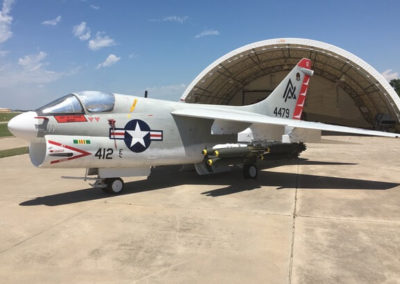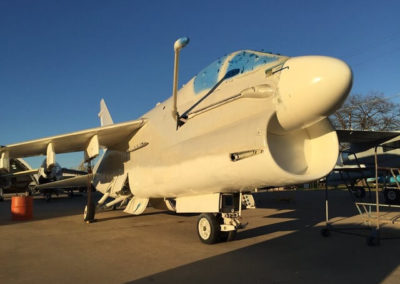A-7B Corsair II
This A-7B Corsair II, Bu No. 154479, was built in Grand Prairie, Texas by Chance Vought in 1968.
Warbird Overview
This A-7B Corsair II, Bu No. 154479, was built in Grand Prairie, Texas by Chance Vought in 1968.
The Vought A-7 Corsair II was developed in the early 1960s as a carrier-capable subsonic light attack aircraft intended to replace the Douglas A-4 Skyhawk. The A-7 airframe was based on the successfulVought F-8 Crusader. It was one of the first combat aircraft to feature a heads-up display (HUD), an inertial navigation system (INS), and a turbofan engine.Vought Aircraft of Dallas received a contract for the first batch A-7s in 1964. The aircraft was named “Corsair II” after Vought’s famous F4U Corsair of World War II. The World War II era fighter was actually aircraft to have the name — the first was the O2U Corsair biplane from the 1920s. The A-7 made its first flight in September 1965 with the Navy receiving its first operational aircraft in 1966. Navy Attack Squadron ONE FOUR SEVEN, VA-147, “Argonauts” was the first to operate the A-7 in 1967. By the end of the year the aircraft was flying over Vietnam.
ABOUT THE A-12 AVENGER II
This A-7B Corsair II, Bu No. 154479, was built in Grand Prairie, Texas by Chance Vought in 1968.
The Vought A-7 Corsair II was developed in the early 1960s as a carrier-capable subsonic light attack aircraft intended to replace the Douglas A-4 Skyhawk. The A-7 airframe was based on the successful Vought F-8 Crusader. It was one of the first combat aircraft to feature a heads-up display (HUD), an inertial navigation system (INS), and a turbofan engine. Vought Aircraft of Dallas received a contract for the first batch A-7s in 1964. The aircraft was named “Corsair II” after Vought’s famous F4U Corsair of World War II. The World War II era fighter was actually aircraft to have the name — the first was the O2U Corsair biplane from the 1920s. The A-7 made its first flight in September 1965 with the Navy receiving its first operational aircraft in 1966. Navy Attack Squadron ONE FOUR SEVEN, VA-147, “Argonauts” was the first to operate the A-7 in 1967. By the end of the year the aircraft was flying over Vietnam.
The 35,000 Vought employees in Dallas turned out one aircraft a day for several years. The aircraft was also adopted by the United States Air Force and the Air National Guard to replace the Douglas A-1 Skyraider, North American F-100 Super Sabre and Republic F-105 Thunderchief. Almost 1,600 aircraft were built in 15 different models. The last US A-7 was retired in 1989.
Fact #1
Lorem ipsum dolor sit amet, consectetur adipiscing elit, sed do eiusmod tempor incididunt ut labore et dolore magna aliqua. Ut enim ad minim veniam, quis nostrud exercitation ullamco laboris nisi ut aliquip ex ea commodo consequat.
Fact #2
Lorem ipsum dolor sit amet, consectetur adipiscing elit, sed do eiusmod tempor incididunt ut labore et dolore magna aliqua. Ut enim ad minim veniam, quis nostrud exercitation ullamco laboris nisi ut aliquip ex ea commodo consequat.
Fact #3
Lorem ipsum dolor sit amet, consectetur adipiscing elit, sed do eiusmod tempor incididunt ut labore et dolore magna aliqua. Ut enim ad minim veniam, quis nostrud exercitation ullamco laboris nisi ut aliquip ex ea commodo consequat.
Manufacturer: Chance Vought Aircraft
Crew: 1
Length: 46 feet 1.5 inches
Wingspan: 38 feet 9 inches
Height: 16 feet 0.75 inches
Wing area: 375 square feet
Airfoil: NACA 65A007 root and tip
Empty weight: 19,490 pounds
Max. takeoff weight: 42,000 pounds
Powerplant: 1 × Allison TF41-A-2 turbofan, 14,500 pounds of thrust
Maximum speed: 600 knots (698 mph)
Combat radius: 621 nautical miles
Ferry range: 2,485 nautical miles with external fuel tanks
Service ceiling: 42,000 feet
Armament:
Guns: 1× 20 mm M61 Vulcan 6-barreled cannon with 1,030 rounds
Hardpoints: 6× under-wing and 2× fuselage pylon stations (for mounting AIM-9 Sidewinder AAMs only) with a capacity of 15,000 pounds and provisions to carry combinations of:
Rockets: 4× LAU-10 rocket pods (each with 4× 127 mm Mk 32 Zuni rockets)
2× AIM-9 Sidewinder AAM
2× AGM-45 Shrike Anti-radiation missile (ARM)
2× AGM-62 Walleye TV-guided Glide bomb
2× AGM-65 Maverick
2× AGM-88 HARM
2× GBU-8 electro-optically guided Glide bomb
Up to 30× 500 pound Mark 82 bombs or Mark 80 series of unguided bombs
Paveway series of laser-guided bombs
Up to 4× B28 nuclear bomb/B57 nuclear bomb/B61 nuclear bombs
Other: up to 4 × 300/330/370 gallon drop tanks
Avionics
Texas Instruments AN/APQ-126 terrain following radar
I had flown that particular aircraft. You prompted me to check my logbook, and these are the dates and missions that I flew the aircraft. Our logbooks were maintained by a clerk, so I cannot attest the accuracy.
1969 Date, Hours, Flying From, Mission (to the best of my recollection)
February 6, 2.2 hours, Lemoore, Mirror Practice
February 28, 1.5 hours, Cubie Point, Low Level training
March 6, 2.4 hours, CVA-14 (USS Ticonderoga), Maintenance Test Flight
March 8, 2.0 hours, CVA-14, Combat – troop support north of Danang
March 11, 2.2 hours, CVA-14, Combat – Laos near Tchepone with FAC
March 30, 2.4 hours, CVA-14, Training – Mines, if I remember correctly
As I recall, the airplane became a “Hanger Queen” serving as a parts donor during April, May and June, when parts shortages were acute. This probably could be verified through the VA-25 maintenance records, or the aircraft logbooks if they are available.
July 1, 2.3 hours, CVA-14, Combat – Laos with FAC
July 15, 2.2 hours, CVA-14, Combat – Laos with FAC (I believe that it was on this hop that I chased a yellow bulldozer away from road reconstruction at least twice! (Probably it was made in Peoria IL and shipped to North Vietnam in an English freighter…). I do not think that I got any direct hits, but I slowed him down a bit with pairs of 500# bombs!
July 20, 2.0 hours, CVA-14, Combat – probably near the tri-border area with FAC
July 21, 2.3 hours, CVA-14, Combat – Central Laos with FAC
July 23, 1.8 hours, CVA-14, Night Combat – probably in Laos. During this time we were triple-cycling (3 back to back flights day and night: 2 hour brief, 2 hour flight, 2 hour debrief for a total of 18 hours a day). I dozed off in the cockpit going feet wet, and felt the shadow of Ross Underhill’s aircraft pass over me. It was a huge adrenalin shot! At 0300 I got an OK-3 pass, and needed an extra shot of medicinal alcohol from the flight surgeon.
July 24, 2.3 hours, CVA-14, From the length of the flight, this should be the flight that I went out as a spare with our sister squadron, VA-86. At the target in Laos the division leader set up a racetrack pattern (we always made our runs from separate directions to make the bad guys firing solutions difficult). After my second pass and pulling up to the racetrack pattern, a number of tracers (37mm or 57mm) came up in the direction I was flying. I rolled inverted, and pulled down about 2000 feet. Rolling upright I saw the flash of the AAC shells going off right where I would have been. I had no gun control radar warnings, and we were flying lights out. I can only surmise that they were tracking us aurally! The NVA were good!
July 27, 2.1 hours, CVA-14, Day Combat
July 28, 1.8 hours, CVA-14, Day combat, near the tri-border in South Vietnam
I wish that I had kept a diary, so that I could give specific mission data. I hope that this helps. Of course, we were not assigned a specific aircraft, but flew whatever aircraft Maintenance could provide for us. We returned from cruise in late September. I flew the aircraft several times at Lemoore before transitioning to the A-7E.
It is possible that BuAer # 154479 did sustain some damage. If the logbooks show damage to the radome and radar, it is possible that it was the aircraft that encountered a 20mm dummy (blue) round, which struck the radome and radar during a dive bomb run. As I recall the round impacted the radome sideways, as though it was spent and was falling. It did inflict quite a bit of damage. In addition, the round showed no rifling. Our spook at the time surmised that it was possible that the NVA salvaged a MK 12 cannon from a downed aircraft and made their own smoothbore barrel. This may also be the reason that the aircraft was out of service for so long. But why was the round a blue dummy?
Courtesy of the FIST OF THE FLEET ASSOCIATION: http://www.fistofthefleet.org
Our Vought A-7B-3-CV Corsair II, Navy Bureau of Aeronautics No. 154479, c/n B-119, was built in 1968 in Dallas or Grand Prairie, Texas. The Navy accepted the aircraft on August 21, 1968.In October 1968, the A-7 was assigned to Attack Squadron ONE TWENTY TWO, VA-122, “Flying Eagles” at NAS LeMoore, California. The unit was also known as “Corsair College.” It carried tail code “NJ” and the aircraft number “_(researching)_”. This unit was a fleet replacement squadron.
The aircraft then served with Navy Attack Squadron TWENTY FIVE, VA-25, “Fists of the Fleet”, beginning in October 1968. It carried the tail code “AH” and was numbered “503.” The squadron made three deployments to Vietnam.
The first deployment was from February 1, 1969, until September 18, 1969, on the USS Ticonderoga to Western Pacific/Vietnam.
The second deployment was October 27, 1970, until June 17, 1971, aboard the USS Ranger to the Western Pacific/Vietnam.
The third deployment was also aboard the USS Ranger from November 16, 1972, until June 23, 1973, to Western Pacific/Vietnam.
Another good Vietnam show piece. Good open cockpit for viewing. Needs new tires as the weight of the wings loaded with Practice MK 82 bombs have flattened the tires to the point they need to be replaces. In need of a good wash and brightening colors and may look at new paint next year for her.
Note: Scheduling is always a moving target depending on weather and workload. All schedules are subject to changes.
Become a Member!
FLIGHT SIMULATOR
Events
Movie Night At the Museum – The A-Team
Lorem ipsum dolor sit amet, consectetur adipiscing elit, sed do eiusmod tempor incididunt ut labore et dolore magna aliqua.
September 11th @ 8PM to 9PM
Movie Night At the Museum – The A-Team
Lorem ipsum dolor sit amet, consectetur adipiscing elit, sed do eiusmod tempor incididunt ut labore et dolore magna aliqua.
September 11th @ 8PM to 9PM
Movie Night At the Museum – The A-Team
Lorem ipsum dolor sit amet, consectetur adipiscing elit, sed do eiusmod tempor incididunt ut labore et dolore magna aliqua.
September 11th @ 8PM to 9PM
Movie Night At the Museum – The A-Team
Lorem ipsum dolor sit amet, consectetur adipiscing elit, sed do eiusmod tempor incididunt ut labore et dolore magna aliqua.
September 11th @ 8PM to 9PM
HOURS
Saturday: 9AM-2PM
Sunday: 11AM-3PM




